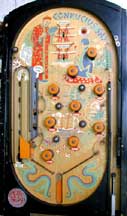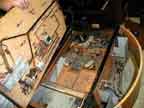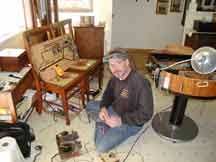Confucius Say
Rotor Table Games, Inc.
369 Lexington Ave.
New York, N.Y.
CAledonia 5-9104
approximately 1935-1937
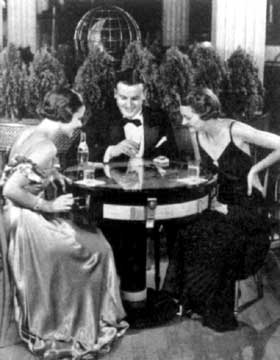
From Encyclopedia of Pinball, Volume 2 by Dick Bueschel:
Rotor Table Gmes, Inc. Booth 68 shows off an experiment in styling. This first cocktail table game of late 1935 was only modestly successful. New Yorkers Gus Chandler and Herman Feldblet promoted the fact that test ROTOR TABLE games were in elegant locations, including the Biltmore Hotel and Jack Dempsey's restaurant and bar. CROSS TOWN model is shown.
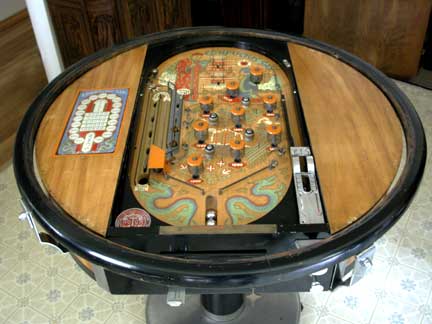
Confucius Say is a Rotor Table pinball designed and perhaps produced around 1936-1937. Rotor Table produced between four and six pinball machines during this time, including Cross Town. It is likely Confucius Say is older because it does have bumpers and so likely postdates Bally's invention of the bumper. Previously, I was unable to find any references to this game in any publication or price guide. Recently however, Terry Cummings found an ad for the game along with six relacement playfields. The ad was from 1942, which adds more information but results in more questions as well. (See ad at the bottom of this page.)
The unique feature of Rotor Table pinball machines was that the games were enclosed in a round table. The table was stationary and was on an art Deco pedestal base. The pinball playfield was under glass and could be rotated to face the player seated around the table by grasping and turning handles on the side. The glass stayed stationary, keeping drinks or ashtrays in front of the player.
Another feature promoted by the company in their advertisements was the ability to replace a playfield in the game with another, thus keeping the players interest without the operator having to buy an entire new game. The ad below shows three interchangeable playfields.
I was most fascinated by the ability for the game to score a multiple of a normal score, as a reward for making a special shot. Later in history, this feature is accomplished with a sequencing unit deep in the machine. The left area of the playfield on Confucius Say has series of capture holes. A ball entering this area is promoted twice, then projected around a U turn and allowed to roll across five contacts, effectively providing 5000 points for one shot. The ball is also returned, to be played again.
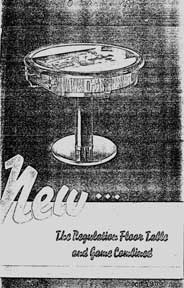
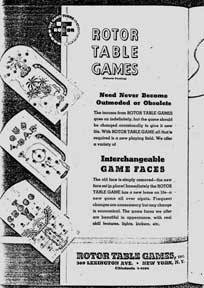
The words from the flyer include:
Need Never Become Outmoded or Obsolete
The income from ROTOR TABLE GAMES goes on indefinitely, but the game should be changed occasionally to give it new life. With ROTOR TABLE GAME, all that is required is a new playing field. We offer a variety of
Interchangeable
GAME FACES
The old face is simply removed-the new faces set in place. Immediately the ROTOR TABLE GAME has a new lease on life - a new game all over again. Frequent changes are unnecessary but any change is economical. The game faces we offer are beautiful in appearance, with real skill features, lights, kickers, etc.
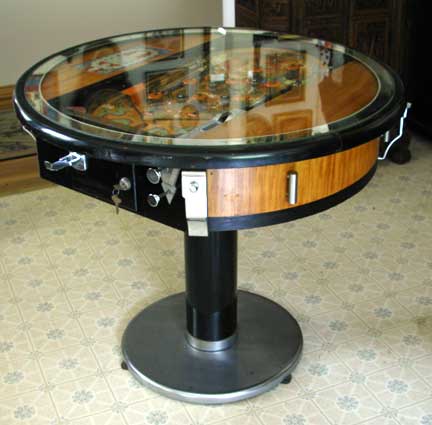
From The Market Place, Page 132 of the Pictorial History series by Bill Gersh, April 1982:
Here was another "new idea" that the manufacturer believed would just absolutely stun the pinball business. It was labeled, "Rotor Table". That's just what it was, alright, just a rotor table. The idea, of course, was that when people sat down with a sandwich and coffee and, provided the waitress didn't place a mat or a table cloths over the table, in addition to ketchup, pepper and salt shakers, a napkin holder, spoons, forks, knives, soft drinks or booze, someone, somehow might see the little game under the glass called, "Cross Town". And who can tell, maybe even throw in a nickel or two while munching on a sandwich. A very, very expensive once-in-a-while nickel play game. Oh, by the way, you didn't have to push the table around, you could spin the game from underneath, if you didn't break the glass so doing the first time. That's how come the name of the game, "Rotor Table". It was rotored right out of the business - real quick."
I think the review above is a bit harsh, and time might have proven it wrong. The modern cocktail table video games did well in waiting areas, pulling in money while people waited to be seated or waited to be served. It seems like it might do well in a bar environment, where a table might pull in some extra play time with a game under the glass. The idea of replaceable playfields was reintroduced by Williams just before leaving the business, so there is still some question as to the success of the idea.
The game has a serial number plate with the number 180.
On the plunger gauge it says "National Die Cast Company, 600 North Albany Avenue, Chicago, Illinois."
The game also has some markings on it that may indicate it was a prop from 20th Century Fox Studio. It is marked on the side near the battery mount-------20C-Fox 32-1-18404. It may have been used in a movie, and their inventory number was #18404?
Patent number 2,100,280 was issued to Oscar Goldberger on November 23, 1937 but was filed on April 16, 1935. The patent is for a rotary table assembly and merely suggests a bagatelle might be used.
There is some question about the dates RotorTable was in business, the dates they produced games, and the date for this game. The Pinball Collectors Resource suggests Rotor Table was in business in 1935 and produced between four and six games. Bally's Bumper, produced in December of 1936 is thought to be the first game with bumpers. Perhaps Rotor Table was in business through 1937 and produced a game with bumpers after Bumper, or Bumper was not the first game with bumpers. I hope the patent search will resolve the timing.
(click on image to see more detail)
Technical Information:
This game is not noted in any lists or databases of known pinball machines. The underneath side of the playfield shows this unit to be of production or first run quality, with no unusual wiring or modified components. Everything seems to have been designed and installed for its obvious purpose.
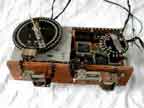
The score unit is also a production unit, but could have been acquired from another game and modified for use in this game. It is a generic score unit with a secondary score unit attached. In the case of Confucius Say, the score unit counts 1000 point increments and upon reaching 20,000 points, is reset and the secondary count score unit is incremented once. The unit is stamped in the metal frame with a "Patent Pending" and appears to be a general design useful in many games.
See also an explanation of how the score wheels work in the mechanism section of the museum.
The game presents a real challenge to power. In order to retain the ability to freely rotate the playfield, battery power of some kind is required. The original game was powered by No. 6 dry cell batteries, 2 5/8" x 2 5/8 width by 6 1/4" tall. The game requires approximately 3 amps to trigger the 1000 score solenoid and more than 5 amps to reset. The design is an early example of pinball logic, however the features were not developed to conserve batteries.
How I Found the Game:
The Sands Mechanical Museum web site frequently receives inquiries about old coin operated games. Owners, excited about their game, use the Internet to search for information. Upon finding a museum, they call or email their questions with the hope of finding out more.
I received a note from Fletcher in May of 2001, asking about his new acquisition and wondering if I might be able to help him get it working again. He sent pictures and because he was 350 miles away, I tried to help from afar. Fletcher enlisted the help of an electrician friend but was still not able to get the game to work. I tried to find the game in my reference library but was unable to do so. I found this curious but was not ready to think this was a new find.
For the next seven months Fletcher and I tried to find a way for me to look at the game. He was very patient and seemed interested in me doing the work even though I offered to try and find a local repair person. During our many conversations, we found we had similar interests. For example we are both members of the Music Box Society International and National Association of Watch and Clock Collectors.
Finally in January of 2002, I needed to attend the Los Angeles Auto Show to cover the introduction of the new Lotus Elise for a magazine. I decided to drive the rest of the way to visit Confucius Say and meet Fletcher. He was a wonderful host, giving me a tour of his palm (plant) collection and showing me many of his mechanical wonders.
I finally looked at Confucius Say and found it to be clearly a 1930s machine but very developed. It was not a home made machine and many components, like the score mechanisms, were designed and built to be mass produced. I still had no idea if this was a rare machine or prototype. I worked on the game for about seven hours, spread out on Fletcher's kitchen floor, and was able to demonstrate it working. The discovery that the machine required six and 12 volts quickly got it operating.
We still need to figure out what batteries to use and what the brackets are for on either side of the playfield.
I visited the game again in April while on Spring Break with the kids. I was able to complete the installation of two gel cell batteries and related charger. I needed to make a couple of changes to the wiring to get the the timer to shut the game off correctly and to get the double light to work. The kids really enjoyed playing the game! I think Fletcher's decision not to plug the game into the wall and installing batteries was the correct one. This game rotates! Interestingly enough, while the game rotates, the glass is stationary. A couple having drinks and dinner on the table will not be switching meals as they take turns playing.
Thanks to Blake Tucker, Russ Jensen, Wayne Namerow, Terry Cumming, Fletcher, Andy Drop, and John Robertson for information helping me understand the game, information on getting it running again, or information on how to identify it.
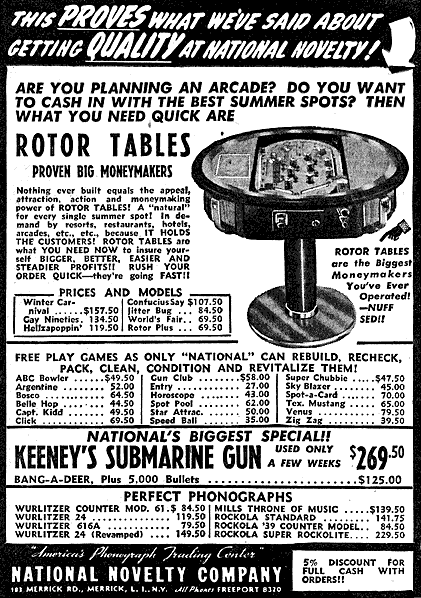
thanks to Terry Cummings for this ad, 1942

